February 19, 2014
I first visited
Chambers Bay Golf Club in October 2013. At that time, I hadn't started this blog, and I didn't take many photos. You can find that first blog
here. I promised myself when I acquired a digital camera, I would go back and play and document Chambers Bay with the respect it deserves. On a side note, Chambers Bay is listed in
Fifty More Places to Play Golf Before You Die. So, here we go.
After parking at the top of the hill near the clubhouse, checking in and paying my green fee, I then took the shuttle down to the practice facility where I warmed up. After hitting each club on the range, I moved to the pitching and putting area. I didn't take any photos of the practice facility because it isn't anything more than just an open field. After finishing my warmup, I caught the shuttle again and road to the starters hut. Upon arrival, you are greeted by the clock. I couldn't have picked a better day weather wise for February. It was high 40s, partly cloudy, and a 10 mph sustained wind. Note if you are unfamiliar with Chambers Bay, it is a walking only facility. They do have a fantastic cadre of caddies here though.
 |
| The clock at the starters hut. |
 |
| One thing I like about Chambers Bay is each hole has a name. It really makes the holes stand out. |
Looking from the tee box at #1, the fairway is wide open, and in parts, connects with the 10th fairway on the right. The fairway slopes gently downhill and to the left before turning uphill next to the big dune on the right. It is also heading directly towards the Puget Sound so if the wind is up, it can make for a very long hole.
 |
| Looking down the fairway from the #1 tee box. |
After landing center fairway, I found my approach shot was going to be a blind shot up over the hill towards the green. I have played Chambers Bay before and knew that once over that hill, it was going to roll down and to the left, away from the green. I put my shot as close to the dune on the right as possible so it would roll towards the green after landing.
 |
| Center of #1 Fairway. |
 |
| From the top of the hill, you are met with a spectacular view of Puget Sound and the green. |
There were temporary greens being used on quite a few holes so that the greens could continue to be prepped for the 2015 U.S. Open. In the photo above, you will see the green would normally be further back and left up the hill. For today's round, the pin had been placed about 30 yards off the green and down to the left.
 |
| The second hole at Chambers Bay honors the 14th hole at Royal Dornoch by taking it's name. |
 |
| A plaque with a brief note explaining the reason behind the name Foxy. |
After a brief walk over the large dune that was on your right at #1, you come to the tee box for #2. As seen in the photo below, it turns to the left. The wind coming in from the Puget Sound on the left will push your ball into no man's land if it is blowing strong enough. I didn't think it would carry my ball too far right, but didn't want to take a chance as there is nothing but trouble on the right, so aimed at the left side of the fairway. I was surprised at how far my ball was pushed right.
 |
| Looking down the fairway from the #2 tee box. |
 |
| A look at the Puget Sound from the middle of Fairway #2. |
From the middle of the fairway, you get a fantastic view of the Puget Sound to your left.
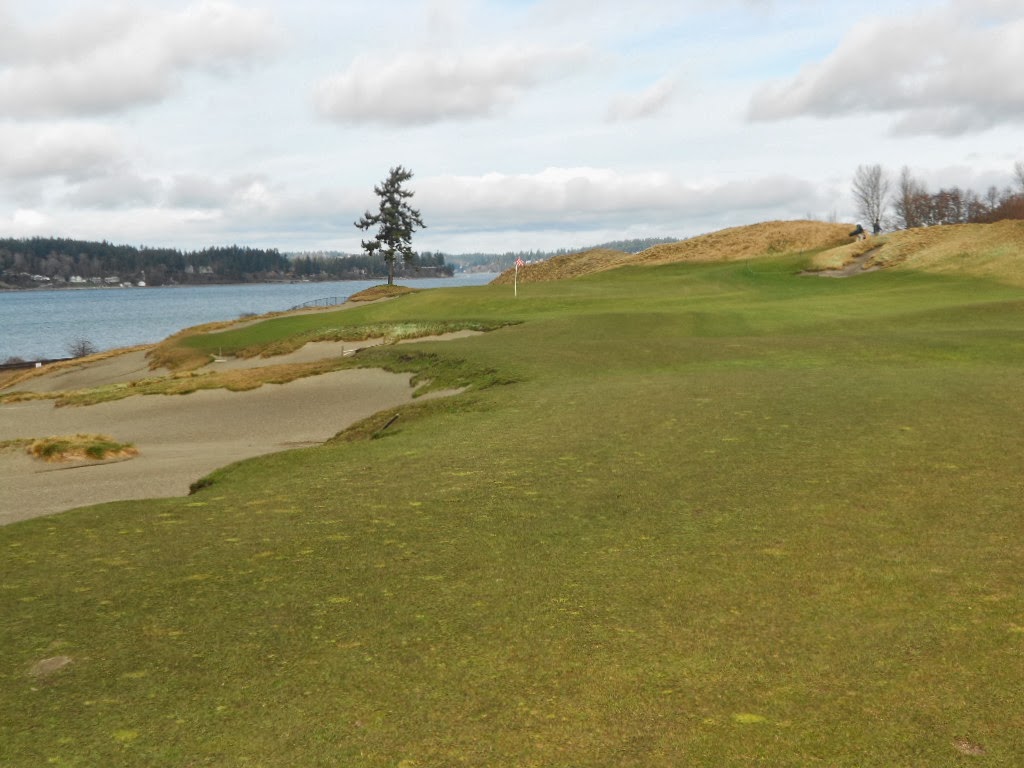 |
| Looking at the approach shot to the #2 green. |
You have to take care when hitting a shot onto the #2 green. It slopes down and to the left. The best play here, especially when the wind is up, is to hit a low running shot that will get to the edge of the green, and let the natural slope move the ball towards the hole.
 |
| Looking back down the #2 fairway from the #2 green. |
I looked for a few minutes but couldn't find the sign for number three. It is a short par 3, again with the Puget Sound to the left, making for a challenging shot when the wind is kicked up.
 |
| Looking towards the green from the #3 tee box. |
I took a photo on my walk to the #3 green to try to give a better perspective of what you are facing. As you can see, the green is guarded along the front and left side by bunkers. If the wind is blowing, it is coming from your left. Fortunately, if the ball is pushed right, the hill will hopefully catch it and let it run back left towards the hole.
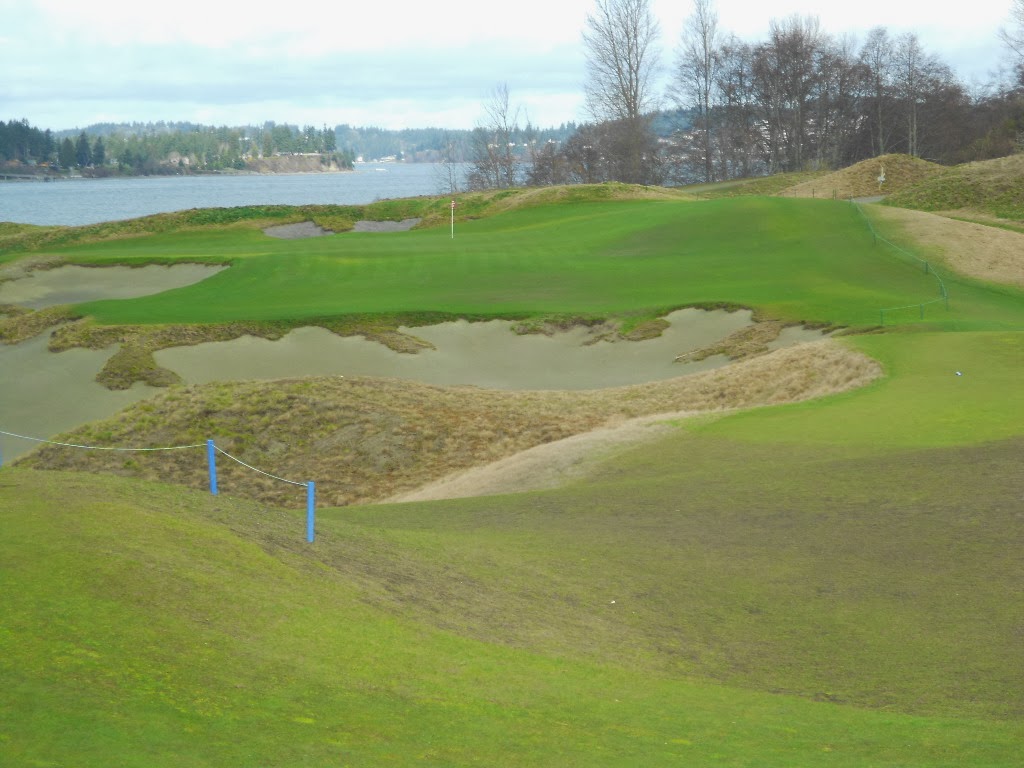 |
| A closer view of the #3 green. |
 |
| A look at the #3 green from the top of the hill on the right. |
 |
| A look at the #3 green from the front left. |
The walk to number 4 is quite a hike. It is a good 2-3 minute walk, all up hill. Luckily there is a restroom house here, along with water fountain.
 |
| Looking down the fairway from the #4 tee box. |
From the blue tees, where I was playing from, it is a long drive to clear the scrub brush and get to the fairway. It had to be a minimum of 210 yards. Luckily, the wind was gusting at my back and pushed the ball easily across the scrub and halfway up the hill.
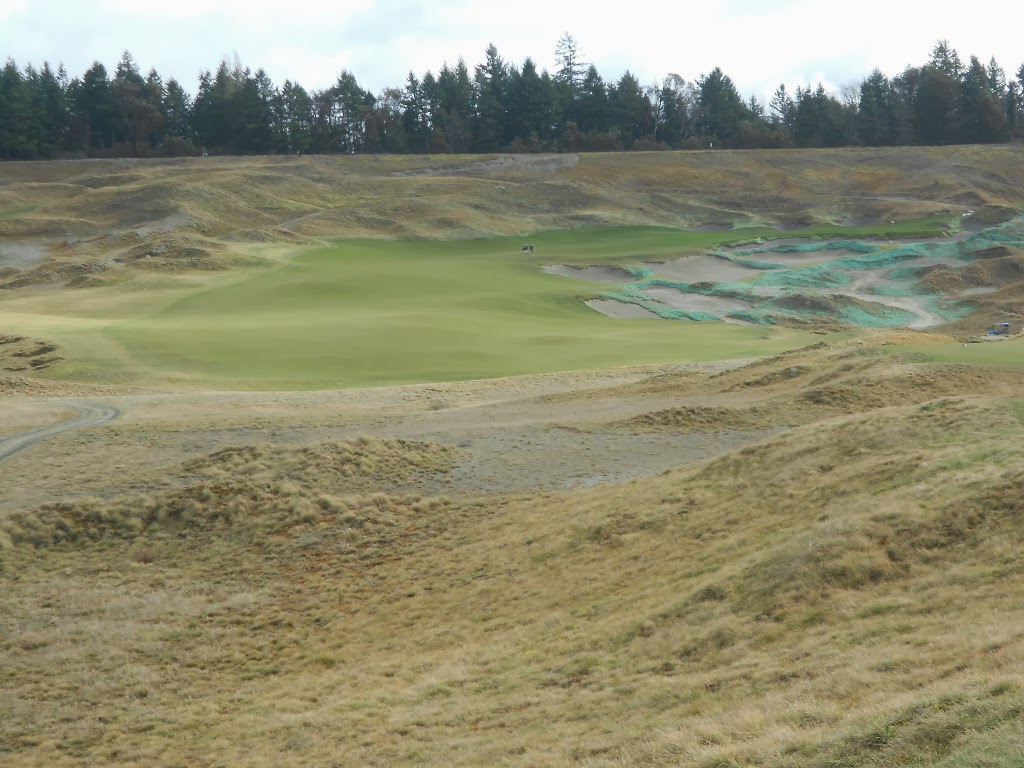 |
| A look from mid scrub brush towards the fairways. The tee boxes are now behind me. |
As you approach the fairway, you get a better picture of just how difficult of a hole this one is. It turns to the right in a pretty severe dogleg, and it is almost all uphill. On the day I was here, they also had some fertilizer down on the mounds in the middle of the sand to make it look lush come spring.
 |
| If you are a long enough hitter, and want to take the risk, you can hit across the sand straight to the green. |
Number four is a definite risk versus reward hole. This is looking to the right from the center of the fairway. I didn't feel I could reach it and keep the ball on the green so I opted to go up the fairway and then back to the right towards the green. If you can make the shot, you are putting for either an eagle or birdie. It is one of my favorite holes and I can't wait to see how the pros play it during the U.S. Open.
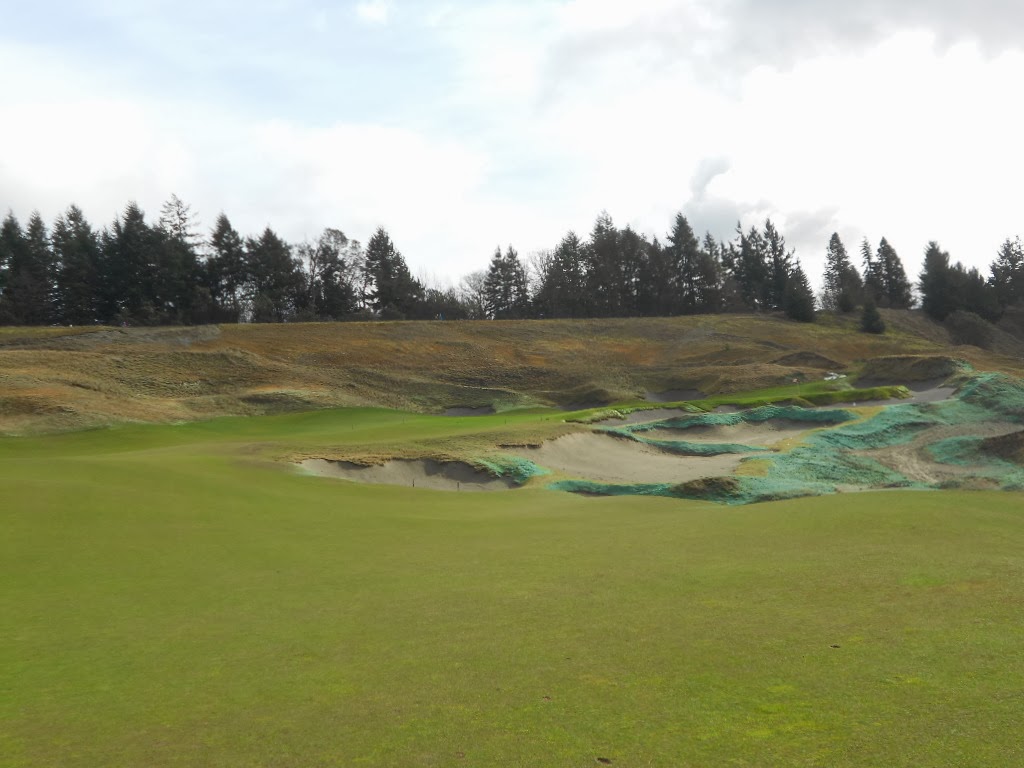 |
| Looking towards the #4 green, |
As you can see above, if you opt for the safe route, you have a pretty decent shot to the green from the fairway.
 |
| As I was walking, I took a closer photo of #4 green to give an idea of just how difficult that shot over the sand can be. |
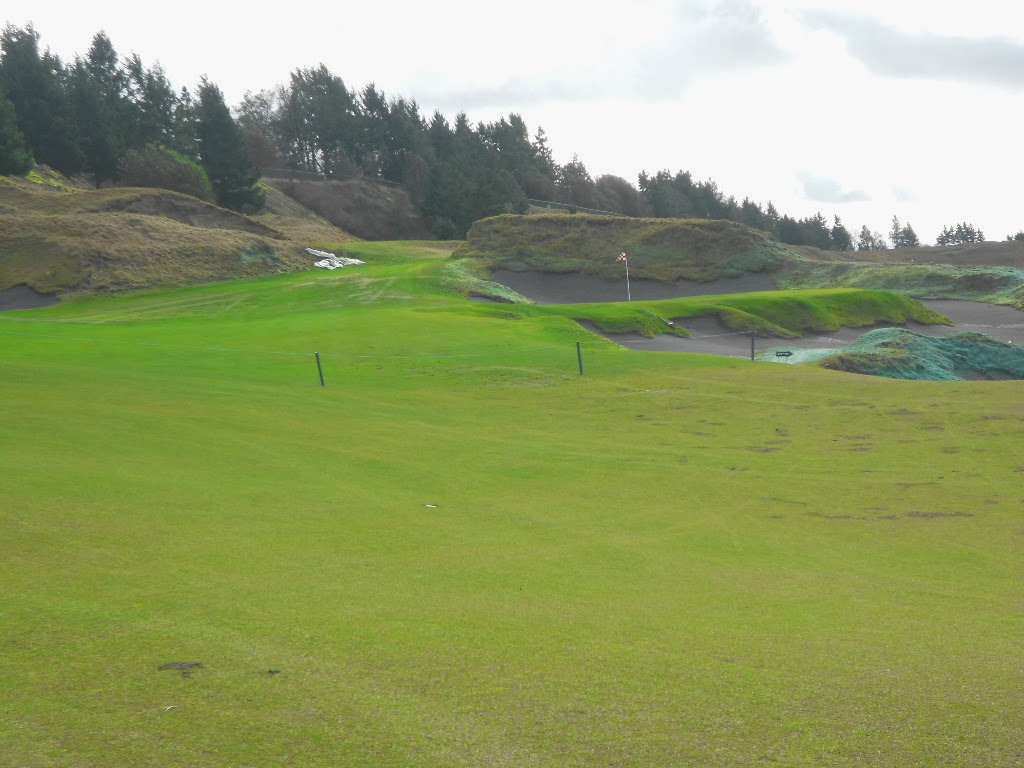 |
| Finally up the green after a long walk up and around on the #4 par 5. |
After deciding to skip trying to cross the sand, I was happy to get up and down for a par on this hole. Above is a photo of my view looking into the green.
Hole #5 is called "Free Fall" for a reason. After finishing up #4, you walk uphill to the tee box and look back towards the Puget Sound. It is likely a 70-75 foot drop from the tee box to the fairway. It is also a fairly wide open fairway which lets you just rip a driver as far as you can. The only thing you have to be careful of is the wind coming directly in from the Puget Sound. If it is strong enough, your ball won't do anything but hang up in the air like a kite.
 |
| A look down the fairway from the #5 tee box. |
 |
| A look from the a location near the second, Tan tee box. |
 |
| A look from the #5 fairway towards the green. |
The green is tucked away just beyond the bunkers and dune on the right. The shot here is to hit it left and let it fade back into the green.
 |
| A look at the #5 green. |
After taking the walk up the fairway, you can see they put in a sneaky, deep pot bunker on the left of the green for those who want to try to hit it left and fade the shot into the green. Luckily it is situated more to the side than directly in front of the green.
Number 6 is also another risk versus reward hole. You can choose to swing out left and then come back in right towards the green. Or, you can go right, and then up and over the dunes for a shorter, but more obscured shot to the green.
 |
| A look at the number 6 green from middle of the fairway. |
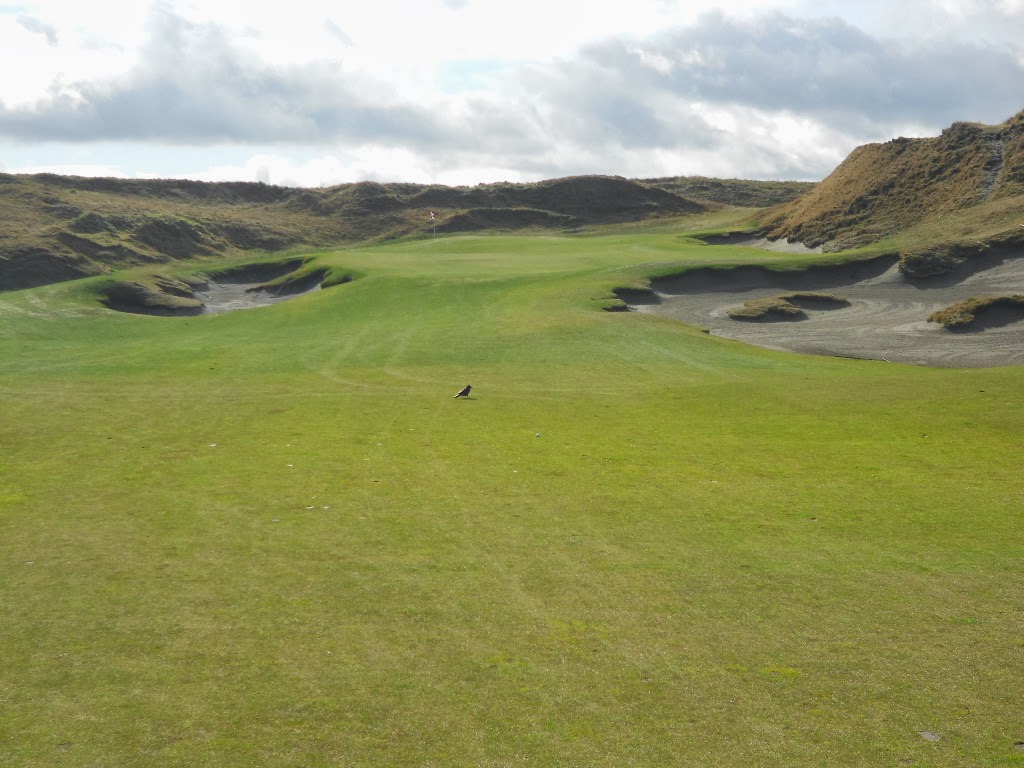 |
| A look into the #6 green. |
 |
| A look back down the #6 fairway from the number 6 green. |
Number 7 is a long drive down the fairway, where it then turns to the right and starts a fairly good climb up hill towards the green. The winds weren't much of a factor on this hole it seemed, as they are largely blocked by the large dunes behind.
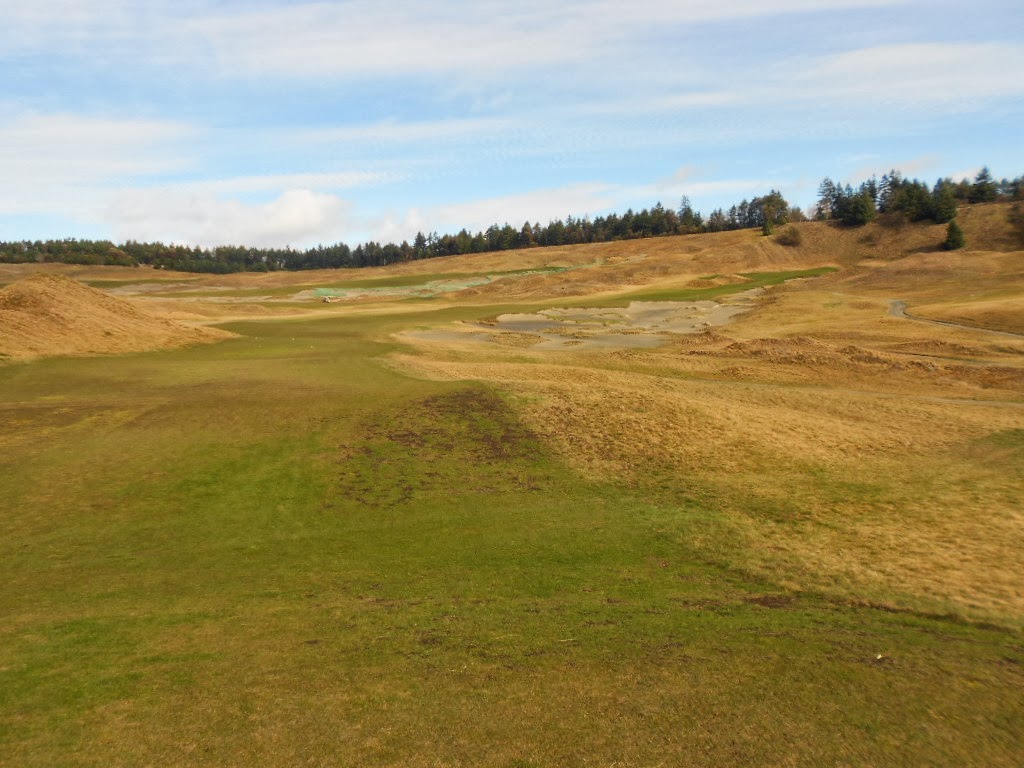 |
| A look down the fairway from the #7 tee box. |
 |
| A look towards the #7 green. |
This is another hole where there were temporary greens in use. The flag was placed in a spot at the start of the steeper incline. The green will usually be at the top of the hill, making for a very difficult par.
 |
| A look down the fairway from the #8 tee box. |
Number 8 is a tough, long hole. It plays across the side of what can only be a cliff. The fairway slopes to the right so care has to be taken not to put the ball too far right or it will be a sacrifice to the golf gods.
 |
| A look at the golf course and Puget Sound from the #9 tee box, |
Hole #9 could be the highest place on the course. It affords outstanding views of the entire course, as well as the Puget Sound. It is also my second choice for a place to sit and watch the 2015 U.S. Open as a spectator.
 |
| A look at the green from the #9 tee box. |
This is a tougher shot than it looks. Initially, one would think a downhill shot to a par 3 green would be fairly routine. However, that wind really kicks up from the Sound and pushes the ball back towards the waste area. The waste area is fairly steep so once down there, you will be very hard pressed to make par. Also, if you send the ball to far past the hole, it will roll down the other side of the hill, leading to just as difficult of a shot from that side. Interestingly, for the U.S. Open, they are going to use two sets of tee boxes, or so I have been told. They will alternate from this location, as well as a location to the bottom right where the players have to hit up towards the green. I can't remember a U.S. Open with such a significance difference in the way a hole has to be played on different days of a tournament.

Making the turn, we come to another hole with a temporary green. I like the way this hole looks when standing on the tee box. The very large mounds on either side give a feeling you are driving into a valley.
 |
| Looking down the fairway from the #10 tee box. |
After landing on the right side of the fairway, you can see that the green is just barely visible. Both times I have played this course, I have ended up on this side of the fairway. I think there would be a better look at the green from the left side.
 |
| Middle of #10 fairway looking towards the green. |
 |
| A look towards the regular green from the temporary green. |
As you can see below, the actual green is going to be situated higher, in a very tight position, with bunkers on your right and a high dune on your left. Once you get to the top of the hill, you have another awesome view of the lower golf course and Puget Sound as you walk to #11.
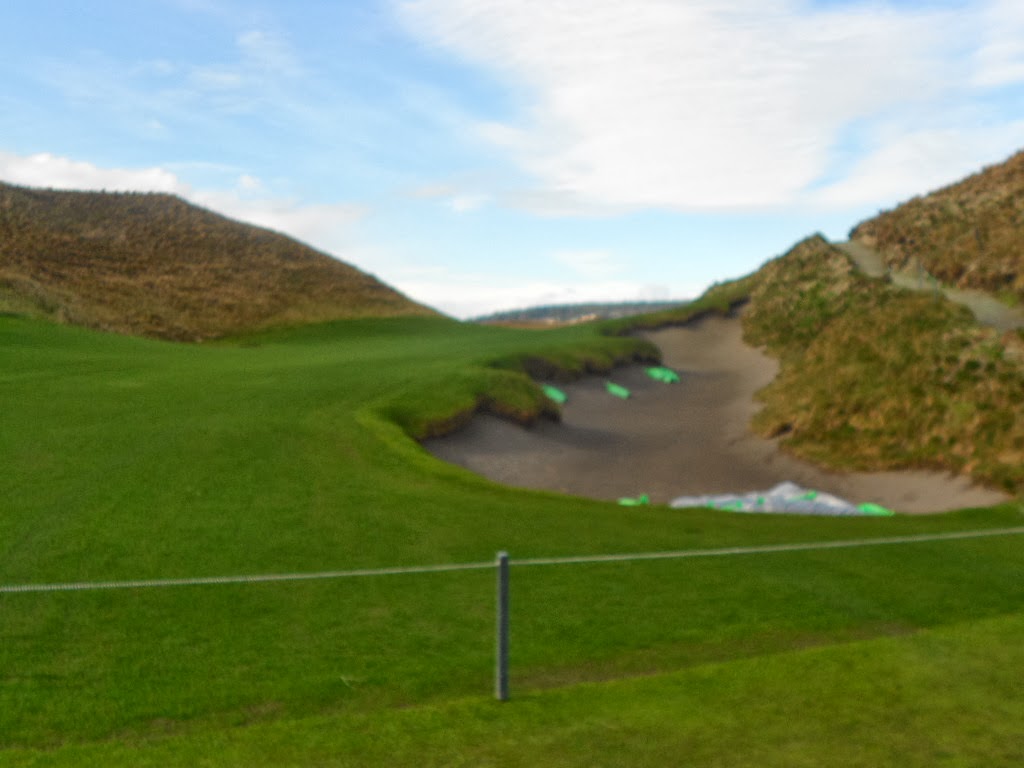 |
| A view of the #10 green growing into form. |
Number 11 is a very strategic hole. There is a large dune in the center of the fairway, and if I remember correctly, it was about 210-220 yards from the blue tee box. That means it probably plays 270-280 from the tips and is smack dab in the way of where most drives are going to land before any roll. Unless you can knock it long, you have to decide if you want to go left or right. I remember the last time that I played, the green slopes fairly significantly from right to left downhill. Last time I went right and had a fairly decent look. So, this time I hit left just to get an idea of what the second shot was like. I will admit, I think it is a much tougher shot from the right side of the dune compared to the left due to the angle you approach the green and the slope.
 |
| A view down the fairway from the #11 tee box. |
 |
| A view of the dune in the center of the fairway. |
As you can see from the above photo, the left side approach gives a great look at the green. The photo from the right side came out blurry. The best I can describe it is that I saw the lower half of the green, and had to take a chance on a blind shot to the high right side of the green to get the ball to roll back towards the hole.
 |
| A view back down #11 fairway from the #11 tee, and a much better view of how large that dune really is. |
 |
| A view looking down the #12 fairway towards the tee box from the #12 green. |
In my opinion, #12 is one of the toughest holes on the course. It is a very short par 4 at around 270. But it plays to a severe uphill fairway, with bunkers lining the left, and the green in a blind spot behind the hill the bunker is located just below. The wind has blown different directions each time I have played here so I think there may be an interesting aerodynamic thing going on where the wind actually swirls a little.
In my opinion, #13 is the most boring hole on the course. There isn't much that stands out about it, at least not here at Chambers Bay. I think I am probably judging it too harshly because #10-#12 are amazing in that they cater to different styles of players and have their own unique features. Number 13 is a long, dogleg right with a few sand traps placed around or near the green. But, in my opinion, if you have to pick the "worst" hole on the course, this would be it.
 |
| A look down the fairway from the #13 tee box. |
 |
| A look from the fairway towards the #13 green. |
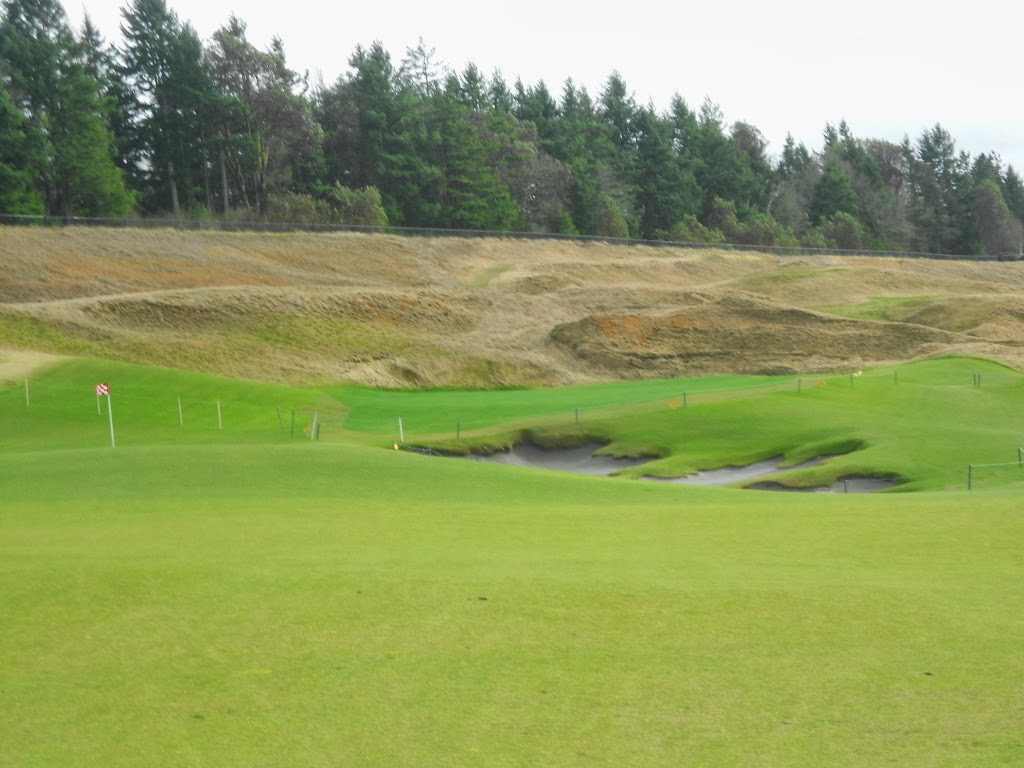 |
| Another temporary green. The regular green is tucked in just past that sand trap. |
 |
| A look down the fairway from the #14 tee box. |
Number 14 makes up for the dullness of hole 13. It is a sizable straight drive to get over the waste area and the fairway then turns to the right and quickly downhill. It was much quicker than I thought. Instead of driving to the right side of the fairway, I drove it directly over the center of the sand trap above. The ball caught the hill and rolled for what seemed like forever, and then rolled down into the sandy area on the far left side of the photo. It was a pain getting up and out of that area and led to me scoring a double bogey.
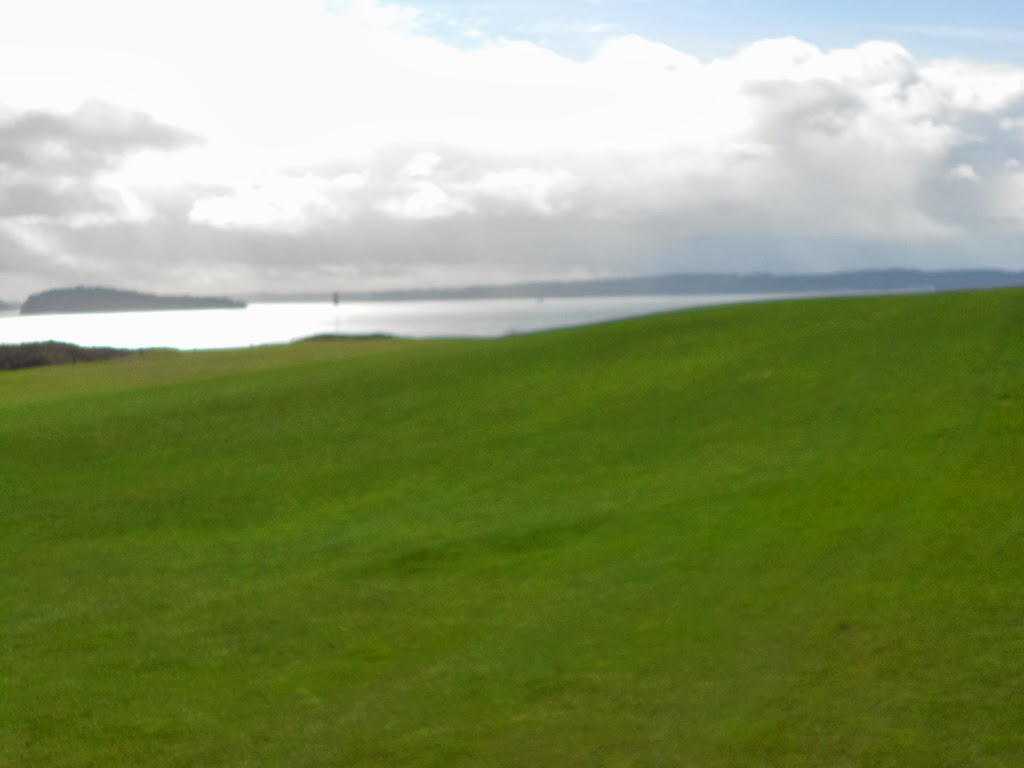 |
| A view of the #14 green from the top right of the fairway. (Sorry for the out of focus shot) |
 |
| A look at the green from the #15 tee box. |
Hole 15 is probably the most photographed hole on the course. Behind the green is the only tree found on the course of any note. It is a lone fir, hence the name of the hole. The last time I played here, the tee boxes were in a different location, far to the left. The view then placed the tree of my left side with a more straight on shot to a longer green. Have a look at my first blog
here for the view from the other tee box. The shot on this day was to a more thiner, but wider, green. The wind blows pretty strong from the Puget Sound on this hole and I found myself going two clubs stronger to make sure I reached the green. It makes me wonder if, like the 9th hole, there will be two different tee box locations for the U.S. Open instead of just one.
 |
| A closer look at the #15 green. |
Hole 16 tees off fairly close to train tracks that the local commuter train, as well as Amtrak utilizes. I noticed three or four trains go by during my round. Just past the tracks is the Puget Sound and it plays down the entire right side of this hole and the next. It is also the closest you get to the Sound during the round and makes for a very memorable finishing stretch (though 18 turns away from the Sound again).
As seen in the photo below, the fairway travels left from the tee box and then turns right towards the green. There is a deep sand trap and waste area that runs the entire length of the hole, including the fairway and the green itself. The closer you get towards the green, the higher the lip of the sand trap gets, making a more difficult shot the closer you get to the green. If you find yourself down there anywhere near the fairly small green, you will be hard-pressed to card a par.
 |
| A look down the fairway from the #16 tee box. |
Hole 17 is a short par 3 that follows the Puget Sound from tee box to green. It is a downhill shot, with approximately 40-50 feet of elevation from tee to green. That is a blessing and a curse. It allows you to combat the wind but your ball is most likely going to hang like a kite. With the green being surrounded, a low straight shot really isn't an option as it will likely catch the lip of the trap and keep you from a GIR. The bunker on the left side of the green is pretty deep, but it is preparing you for the monster one you find on 18.
 |
| A look towards the green from the #17 tee box. |
 |
| A look down the fairway from the #18 tee box. |
The 18th is a long drive to center, where the fairway then turns to the right. It turns back to the left, and then again back to the right towards the green, creating a small, S-type of fairway.
 |
| A mid fairway view of the 18th green. |
One interesting aspect of the 18th is the deepest bunker I have ever seen, and is right in the range of where shots will land. I am looking forward to seeing a pro go into this hole and see how the handle getting out.
 |
| A closer view of the green and the bunker you do not want to find yourself in. |
 |
| The ridiculously deep bunker. |
The photo above doesn't do justice to just how deep this bunker is. It is somewhere between six to eight feet deep. In my first blog
here you can see a photo of my son, who is 6'1", standing at the bottom of it. I luckily have never gone into this bunker either time I have played here and hope I never do.
Overall, I came away with the same impression I had the first time. This is going to be a fantastic, and interesting location for the U.S. Open. There are so many different holes here that it is going to test every golfer in the field. There is also plenty of great spots to view the tournament as a spectator. I know I have already chosen my spot. After playing Bandon Dunes, I can see why Chambers Bay is not rated top 100 in the world. I do think it probably should be ranked a little higher on the U.S. list as I found it much more interesting an enjoyable, and much more scenic than a few other top 100 U.S. courses I have played.
If you ever find yourself in the Seattle area, and want me to join you for a round at Chambers Bay, please don't hesitate to email me and let me know.

